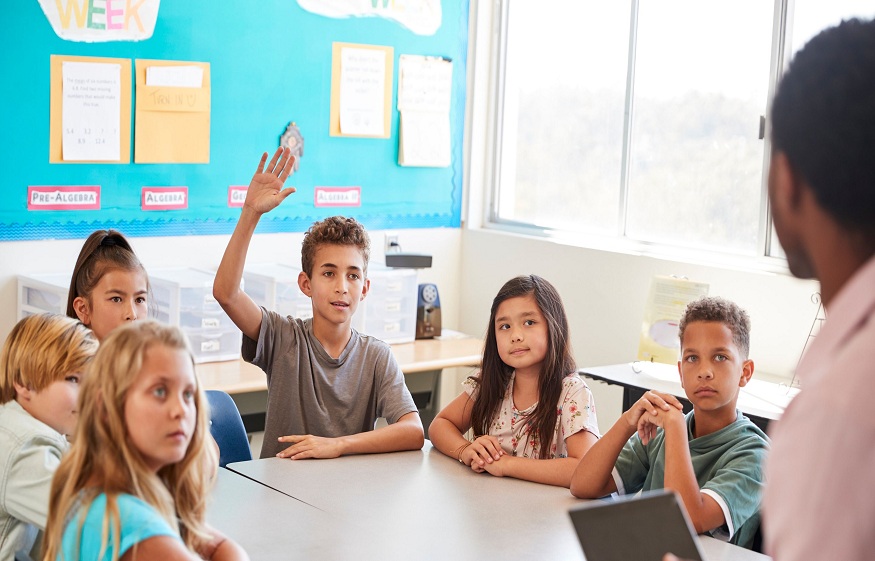The main objective of this guide is to help teachers design and practice regular, motivating and effective teaching of modern languages, based on solid theoretical bases and on examples of implementation described in great detail. Rather than a manual to be followed step by step, this is a methodological tool intended to explain the issues of the discipline and provide benchmarks that help the teacher to build teaching sequences.

This teaching guide aims to support teachers in a progressive and coherent teaching in modern foreign languages from entry to first grade until arrival at college.
The first part of this document lays down the elements of the conceptual framework that the teacher can appropriate to establish his practice on a solid base. It recalls the expectations defined by the regulatory texts that govern this teaching and relies on the contributions of research to provide very concrete advice for implementation in the classroom.
The second part offers examples of pedagogical progression declined in four living languages: German, English, Spanish and Italian. They follow a common pattern which consists in showing how a coherent course in language can be built from school to arrival in college. These progressions are based on the programs of cycles 2 and 3, are articulated around the language activities of the oral mainly and the cultural themes of the studied language. They are based on the levels of the Common European Framework of Reference for Languages (CEFRL) targeted for each level and each cycle.
The examples, although distinct in their linguistic and cultural content and objectives, highlight a number of key steps common to any language session. They point out for the teacher a certain number of benchmarks which will help him then to construct his own sequences. Other examples of progressions will be posted online.
The aim of the guide is to support the development of teaching in modern foreign languages in schools, colleges and high schools, in France and in the network of French education abroad.
The report For a better mastery of foreign languages, dare to say the new world , made public in September 2018, recommends developing organizational methods that add cultural, physical and sports activities to the hours of modern language lessons stricto sensu , as well as lessons in other disciplines taught in a foreign language.
The main objective of this guide is to help teachers design and practice regular, motivating and effective teaching of modern languages, based on solid theoretical bases and on examples of implementation described in great detail. Rather than a manual to be followed step by step, this is a methodological tool intended to explain the issues of the discipline and provide benchmarks that help the teacher to build teaching sequences.
This teaching guide aims to support teachers in a progressive and coherent teaching in modern foreign languages from entry to first grade until arrival at college.
The first part of this document lays down the elements of the conceptual framework that the teacher can appropriate to establish his practice on a solid base. It recalls the expectations defined by the regulatory texts that govern this teaching and relies on the contributions of research to provide very concrete advice for implementation in the classroom.
The second part offers examples of pedagogical progression declined in four living languages: German, English, Spanish and Italian. They follow a common pattern which consists in showing how a coherent course in language can be built from school to arrival in college. These progressions are based on the programs of cycles 2 and 3, are articulated around the language activities of the oral mainly and the cultural themes of the studied language. They are based on the levels of the Common European Framework of Reference for Languages (CEFRL) targeted for each level and each cycle.
The examples, although distinct in their linguistic and cultural content and objectives, highlight a number of key steps common to any language session. They point out for the teacher a certain number of benchmarks which will help him then to construct his own sequences. Other examples of progressions will be posted online.
The aim of the guide is to support the development of teaching in modern foreign languages in schools, colleges and high schools, in France and in the network of French education abroad.
The report For a better mastery of foreign languages, dare to say the new world , made public in September 2018, recommends developing organizational methods that add cultural, physical and sports activities to the hours of modern language lessons stricto sensu , as well as lessons in other disciplines taught in a foreign language.
This guide aims to support very concretely the development of language teaching , in schools, colleges and high schools, in France and in the network of French education abroad, to constitute reinforced courses for the benefit of the greatest number of students.
In the first part , it will essentially be a question of the management methods to be put in place to deal with the human, regulatory, administrative and technical questions posed by the creation and management of these courses, by identifying the issues specific to the first and second. degree. The guide is based on the experience acquired by certain academies in order to draw from it the elements of a project management method, anticipate difficulties and point out the obligatory stages.
The second part concerns the implementation in the first and second degree classes ; many examples show that a progressive approach is possible, which ranges from the simple use of language instructions in the classroom to teaching on a parity schedule, including the teaching of a subject or a subject area in language foreign.
The question of the evaluation and the valuation of these devices , for the pupils, the professors and the supporting establishments, is approached in a third part .
In the first part , it will essentially be a question of the management methods to be put in place to deal with the human, regulatory, administrative and technical questions posed by the creation and management of these courses, by identifying the issues specific to the first and second. degree. The guide is based on the experience acquired by certain academies in order to draw from it the elements of a project management method, anticipate difficulties and point out the obligatory stages.
The second part concerns the implementation in the first and second degree classes ; many examples show that a progressive approach is possible, which ranges from the simple use of language instructions in the classroom to teaching on a parity schedule, including the teaching of a subject or a subject area in language foreign.
The question of the evaluation and the valuation of these devices , for the pupils, the professors and the supporting establishments, is approached in a third part .






Leave a Reply
You must be logged in to post a comment.